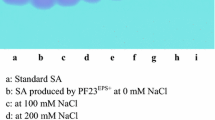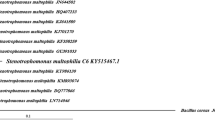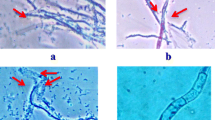Abstract
Isolate PF23 selected from among 110 fluorescent pseudomonads, identified as Pseudomonas aeruginosa, displayed salinity tolerance and exopolysaccharides (EPS) production up to 2,000 mM NaCl concentration. EPS-defective mutant PF23EPS− of the isolate showed 86 % reduction in EPS production in comparison with wild strain. Defect in EPS production brought loss in salt tolerance capability. Purified EPS obtained from PF23 displayed multiple roles. At low concentration EPS functioned as biocontrol agent, at high concentration EPS behaved as osmoprotective or stress ameliorating metabolite and when introduced in saline soil, served as a plant growth promotor along with seed biopriming agent. Both in planta and in vivo studies were performed taking sunflower as a test crop and it was observed that PF23 showed plant growth promotion and significant biocontrol potential against dreadful phytopathogen Macrophomina phaseolina (under saline conditions). The mutant PF23EPS− was ineffective under saline conditions both in growth enhancement as well as in disease suppression. The study reports a potent strain, Pseudomonas aeruginosa PF23, capable of enhancing production of sunflower crop in semiarid regions and minimizing the incidence of charcoal rot disease in sunflower.


Similar content being viewed by others
References
Alami Y, Achouak W, Marol C, Heulin T (2000) Rhizosphere soil aggregation and plant growth promotion of sunflowers by an exopolysaccharide-producing Rhizobium sp. strain isolated from sunflower roots. Appl Environ Microbiol 66:3393–3398
Altschul SF, Gish W, Miller W, Meyers EW, Lipman DJ (1990) Basic local alignment search tool. J Mol Biol 215:403–410
Anju P, Milind N, Kumar SD (2010) Hemolysin, protease, and EPS producing pathogenic Aeromonas hydrophila strain and shows antibacterial activity against marine bacterial fish Pathogens. J Marine Biol 10:19
Arora NK, Kang SC, Maheshwari DK (2001) Isolation of siderophore inducing strains of Rhizobium meliloti and their biocontrol potential against Macrophomina phaseolina that causes charcoal rot of ground nut. Curr Sci 81:673–677
Arora NK, Tewari S, Singh S, Lal N, Maheshwari DK (2012) PGPR for protection of plant health under saline conditions. In: Maheshwari DK (ed) Bacteria in agrobiology: stress management. Springer, pp 239–258
Arora NK, Tewari S, Singh R (2013) Multifaceted plant-associated microbes and their mechanisms diminish the concept of direct and indirect PGPRs. In: Arora NK (ed) Plant microbe symbiosis: fundamentals and advances. Springer, pp 412–438
Ashraf M, Hasnain S, Berge O (2006) Effect of exo-polysaccharides producing bacterial inoculation on growth of roots of wheat (Triticum aestivum L.) plants grown in a salt-affected soil. Int J Environ Sci Technol 3(1):43–51
Atkin RK, Spencer DM, Wain RL (1964) Investigators of fungicides X. The antifungal activity of 2-deoxy-d-glucose. Ann Appl Biol 53:437–443
Barnett HL, Lilly UG (1951) The inhibitors effect of sorbose on fungi. Science 114:439–444
Bashan Y, de-Bashan LE (2005) Fresh-weight measurements of roots provide inaccurate estimates of the effects of plant growth-promoting bacteria on root growth: a critical examination. Soil Biol Biochem 37:1795–1804
Biely P, Krátky Z, Kovark J, Bauer S (1971) Effect of 2-deoxyglucose on cell wall formation in Saccharomyces cerevisiae and its relation to cell growth inhibition. J Bacteriol 107:121–129
Crowe JH, Crowe LM (1986) Stabilization of membranes in anhydrobiotic organisms. In: Leopold AC (ed) Membranes, metabolism and dry organisms, 1st edn. Cornell University Press, Ithaca, pp 188–209
Crowe JH, Crowe LM (1992) Membrane integrity in anhydrobiotic organisms: toward a mechanism for stabilizing dry cells. In: Somero GN, Osmond CB, Bolis CL (eds) Water and life, 1st edn. Springer, Berlin, pp 87–103
Dubois M, Gilles KA, Hamilton JK, Rebers PA, Smith F (1956) Colorimetric methods for determination of sugars of related substances. Anal Chem 28:350–356
Dunne C, Crowely JJ, Moenne-Loccoz Y, Dowling DN, de Brujin FJ, O’Gara F (1997) Biological control of Pythium ultimum by Stenotrophomonas maltophislia W81 is mediated by an extracellular proteolytic activity. Microbiology 143:3921–3931
El Ghaouth A, Wilson CL, Wisniewski ME (1995) Sugar analogs as potential fungicides for postharvest pathogens of apple and peach. Plant Dis 79:254–258
El Ghaouth A, Wilson CL, Wisniewski ME (1997) Antifungal Activity of 2-Deoxy-d-Glucose on Botrytis cinerea, Penicillium expansum, and Rhizopus stolonifer: ultrastructural and cytochemical aspects. Phytopathology 87(7):772–779
Engelke TH, Jagadish MN, Puhler A (1987) Biochemical and genetical analysis of R. meliloti mutants defective in C4-dicarboxylate transport. J Gen Microbiol 133:3019–3029
Fett WF, Osman SF, Fishman ML, Siebles TS III (1986) Alginate production by plant pathogenic pseudomonads. Appl Environ Microbiol 52:466–473
Fett WF, Osman SF, Dunn MF (1989) Characterization of exopolysaccharides produced by plant associated fluorescent pseudomonads. Appl Environ Microbiol 55:579–s583
Gaballa A, Abeysinghe PD, Urich G, Matthijs S, De Greve H, Cornelis P, Koedam N (1997) Trehalose induces antagonism towards Pythium debaryanum in Pseudomonas fluorescens ATCC 17400. Appl Environ Microbiol 63:4340–4345
Garrity G (2005) The proteobacteria, Part B the gammaproteobacteria. In: Brenner DJ, Krieg NR, Staley JT (eds) Bergey’s manual of systematic bacteriology, vol 2, 2nd edn. Springer, New York, pp 323–379
Gupta CP, Sharma A, Dubey RC, Maheshwari DK (1999) Pseudomonas aeruginosa as a strong antagonist of Macrophomina phaseolina and Fusarium oxysporum. Cytobios 99:183–189
Gurusiddaiah S, Weller DM, Sarkar A, Cook RJ (1986) Characterization of antibiotic produced by a strain of Pseudomonas fluorescens inhibitory to Gaeumannomyces graminis var. tritici and Pythium spp. Antimicrob Agents Chemother 29:488–495
Horborne JB (1976) Phytochemical methods. Chapman and Hall, London, p 33
Ijaz S, Sadaqat HA, Khan MN (2013) A review of the impact of charcoal rot (Macrophomina phaseolina) on sunflower. J Agric Sci 151(2):222–227
Joe MM, Sivakumaar PK (2009) Role of certain cationic compounds on the enhancement of flocculation in Azospirillum brasilense MTCC-125: Bioinoculation effect on growth of sunflower. Die Bodenkultu 60(4):5–13
Joshi KK, Kumar V, Dubey RC, Maheshwari DK (2006) Effect of chemical fertilizer adaptive variants, Pseudomonas aeruginosa GRC2 and Azotobacter chroococcum AC1 on Macrophomina phaseolina causing charcoal rot of Brassica juncea. Korean J Environ Agric 25:228–235
Khan SN (2007) Macrophomina phaseolina as causal agent for charcoal rot of sunflower. Mycopath 5(2):111–118
Khare E, Arora NK (2010) Effect of Indole-3-Acetic Acid (IAA) Produced by Pseudomonas aeruginosa in Suppression of Charcoal Rot Disease of Chickpea. Curr Microbiol 61:64–68
Khare E, Singh S, Maheshwari DK, Arora NK (2011) Suppression of charcoal rot of chickpea by Fluorescent Pseudomonas under saline stress condition. Curr Microbiol 62:1548–1553
Kragelund L, Hosbond C, Nybroe O (1997) Distribution of metabolic activity and phosphate starvation response of lux-tagged Pseudomonas fluorescence reporter bacteria in the barley rhizosphere. Appl Environ Microbiol 63:4920–4928
Krátky Z, Biely P, Bauer S (1975) Mechanism of 2-deoxy-d-glucose inhibition of cell wall polysaccharide and glycoprotein biosynthesis in Saccharomyces cerevisiae. Eur J Biochem 54:459–467
Kussainova M, Durmuş M, Erkoçak A, Kızılkaya R (2013) Soil dehydrogenase activity of natural macro aggregates in a toposequence of forest soil. Eur J Soil Sci 2:69–75
Maheshwari DK, Dubey RC, Aeron A, Kumar B, Kumar S, Tewari S, Arora NK (2012) Integrated approach for disease management and growth enhancement of Sesamum indicum L. utilizing Azotobacter chroococcum TRA2 and chemical fertilizer. World J Microbiol Biotechnol 28(10):3015–3024
Maidak BL, Cole JR, Lilburn TG, Parker CT, Saxman PR, Stredwick JM, Garrity GM, Li B, Olsen GJ, Pramanik S, Schmidt TM, Tiedje JM (2000) The RDP (ribosomal database project continues. Nucleic Acids Res 28:173–174
Miller RL, Higgins BB (1970) Association of cyanide with infection of birds foot trefoil by Stemphylium loti. Phytopathology 60:104–111
Orsod M, Joseph M, Huyop F (2012) Characterization of Exopolysaccharides Produced by Bacillus cereus and Brachybacterium sp. Isolated from Asian Sea Bass (Lates calcarifer). Malasiyan. J Microbiol 8(3):170–174
Pandey PK, Yadav SK, Singh A, Sarma BK, Mishra A, Singh HB (2012) Cross-species alleviation of biotic and abiotic stresses by the endophyte Pseudomonas aeruginosa PW09. J Phytopathol 160:532–539
Potts M (1994) Desiccation tolerance of prokaryotes. Microbiol Rev 58:755–805
Prı´ncipe A, Alvarez F, Castro MG, Zachi L, Fischer SE, Mori GB, Jofre´ E (2007) Biocontrol and PGPR features in native strains isolated from saline soils of Argentina. Curr Microbiol 55:314–322
Ramadoss D, Lakkineni VK, Bose P, Ali S, Annapurna K (2013) Mitigation of salt stress in wheat seedlings by halotolerant bacteria isolated from saline habitats. Springer Plus 2(6):1–7
Ranal MA, Santana DG (2006) How and why to measure the germination process? Rev Bras Biol 29:1–11
Räsänen LA, Saijets S, Jokinen K, Lind-ström K (2004) Evaluation of the roles of two compatible solutes, glycine betaine and trehalose, for the Acacia senegal–Sinorhizobium symbiosis exposed to drought stress. Plant Soil 260:237–251
Roberson EB, Firestone MK (1992) Relationship between desiccation and exopolysaccharide production in a soil Pseudomonas sp. Appl Environ Microbiol 58:1284–1291
Saitou N, Nei M (1987) The neighbor-joining method: A new method for reconstructing phylogenetic trees. Mol Biol Evol 4(4):406–425
Sandhya V, Ali SKZ, Minakshi G, Reddy G, Venkateswarlu B (2009) Alleviation of drought stress effects in sunflower seedlings by the exopolysaccharides producing Pseudomonas putida strain GAPP45. Biol Fertil Soils 46:17–26
Sandhya V, Ali SZ, Venkateswarlu B, Reddy G, Grover M (2010) Effect of osmotic stress on plant growth promoting Pseudomonas spp. Arch Microbiol 192:867–876
Sanker GRM, Vanaja M, Maruthi V, Reddy PR, Murthy DN (2004) Selection of consistant plant traits for sunflower growth using principal components analysis. Helia 27(4):113–122
Sarma RK, Saikia R (2014) Alleviation of drought stress in mung bean by strain Pseudomonas aeruginosa GGRJ2. Plant Soil. 377:111–126
Schwyn B, Neilands JB (1987) Universal assay for the detection and determination of siderophores. Anal Biochem 160:47–56
Shankar CVS, Malar AHJ, Punitha SMJ (2010) Antimicrobial activity of marine bacteria associated with Polychaetes. Biores Bull 1:24–28
Škorić D (2009) Sunflower breeding for resistance to abiotic stresses. Helia 32(50):1–16
Subba-Rao NS (1982) Advances in agricultural microbiology. In: Subba-Rao NS (ed) Studies in the agriculture and food sciences. Butterworth Scientific, London, pp 295–303
Titus S, Gasnkar N, Srivastava KB, Karande AA (1995) Exopolymer production by a fouling marine bacterium Pseudomonas alcaligenes. Indian J Mar Sci 24:45–48
Ullah MH, Khan MA, Sahi ST, Habib A (2011) Evaluation of antagonistic fungi against charcoal rot of sunflower caused by Macrophomima phaseolina (Tassi) Goid. J Appl Sci Res 2(12):1175–1184
Validov S, Kamilova F, Qi S, Stephan D, Wang JJ, Makarova N, Lugtenberg B (2007) Selection of bacteria able to control Fusarium oxysporum f. sp. radicis-lycopersici in stonewool substrate. J Appl Microbiol 102:461–471
Webb SJ (1965) Bound water in biological integrity. Charles C Thomas Publisher, Spring Weld
Nayak A, Gracy CP, Nagashree N, Girisha K. An overview of Sunflower in India. http://www.krishisewa.com/cms/articles/miscellaneous/284-sunflower.html
Acknowledgments
Thanks are due to Department of Biotechnology, Ministry of Science & Technology, New Delhi and Council of Science and Technology, Lucknow, India for financial support. Authors are grateful to Vice Chancellor, BBA University, Lucknow, India for support.
Author information
Authors and Affiliations
Corresponding author
Rights and permissions
About this article
Cite this article
Tewari, S., Arora, N.K. Multifunctional Exopolysaccharides from Pseudomonas aeruginosa PF23 Involved in Plant Growth Stimulation, Biocontrol and Stress Amelioration in Sunflower Under Saline Conditions. Curr Microbiol 69, 484–494 (2014). https://doi.org/10.1007/s00284-014-0612-x
Received:
Accepted:
Published:
Issue Date:
DOI: https://doi.org/10.1007/s00284-014-0612-x




